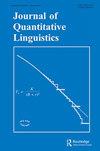Comparing Lexical Bundles across Corpora of Different Sizes: The Zipfian Problem
IF 1.7
2区 文学
0 LANGUAGE & LINGUISTICS
引用次数: 14
Abstract
ABSTRACT Formulaic sequences in language use are often studied by means of the automatic identification of frequently recurring series of words, often referred to as ‘lexical bundles’, in corpora that contrast different registers, academic disciplines, etc. As corpora often differ in size, a critically important assumption in this field states that the use of a normalized frequency threshold, such as 20 occurrences per million words, allows for an accurate comparison of corpora of different sizes. Yet, several researchers have argued that normalization may be unreliable when applied to frequency threshold. The study investigates this issue by comparing the number of lexical bundles identified in corpora that differ only in size. Using two complementary random sampling procedures, subcorpora of 100,000 to two million words were extracted from five corpora, with lexical bundles identified in them using two normalized frequency thresholds and two dispersion thresholds. The results show that many more lexical bundles are identified in smaller subcorpora than in larger ones. This size effect can be related to the Zipfian nature of the distribution of words and word sequences in corpora. The conclusion discusses several solutions to avoid the unfairness of comparing lexical bundles identified in corpora of different sizes.不同大小语料库的词丛比较:Zipfian问题
语言使用中的公式化序列通常是通过自动识别语料库中频繁出现的一系列单词来研究的,这些单词通常被称为“词汇束”,这些语料库与不同的语域、学科等形成对比。由于语料库的大小通常不同,因此该领域的一个至关重要的假设是使用标准化的频率阈值,例如每百万单词出现20次,可以对不同大小的语料库进行准确的比较。然而,一些研究人员认为,当应用于频率阈值时,归一化可能不可靠。该研究通过比较语料库中仅在大小上不同的词汇束的数量来调查这个问题。采用两种互补的随机抽样方法,从5个语料库中提取10万至200万词的子语料库,并使用两个归一化频率阈值和两个离散阈值识别其中的词汇束。结果表明,较小的亚语料库比较大的亚语料库识别出更多的词汇束。这种大小效应可能与语料库中单词和单词序列分布的Zipfian性质有关。结语部分讨论了避免不同大小语料库中词汇束比较不公平的几种解决方案。
本文章由计算机程序翻译,如有差异,请以英文原文为准。
求助全文
约1分钟内获得全文
求助全文
来源期刊

Journal of Quantitative Linguistics
Multiple-
CiteScore
2.90
自引率
7.10%
发文量
7
期刊介绍:
The Journal of Quantitative Linguistics is an international forum for the publication and discussion of research on the quantitative characteristics of language and text in an exact mathematical form. This approach, which is of growing interest, opens up important and exciting theoretical perspectives, as well as solutions for a wide range of practical problems such as machine learning or statistical parsing, by introducing into linguistics the methods and models of advanced scientific disciplines such as the natural sciences, economics, and psychology.
 求助内容:
求助内容: 应助结果提醒方式:
应助结果提醒方式:


